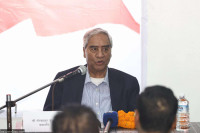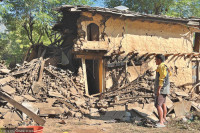Opinion
Waiting for the rain
Investment in irrigation infrastructure and energy can help farmers cope with a delayed monsoon
Aditi Mukherji & Mandira Singh Shrestha
A poor monsoon is terrible news for our region’s agriculture, given the limited irrigation facilities and heavy reliance on rain-fed farming. The slow pace of paddy transplantation in Nepal is making headlines while the hike in prices and hoarding is making news in India. If monsoon rains do not catch up soon, it will have serious implications on food security, food prices and overall economic growth in the region. There is not much we could have done about the delayed onset of monsoon but perhaps there were ways in which its negative impact on agriculture could have been reduced.
Energy and infrastructure
The negative impacts on agriculture could have been partly averted by concerted investments in irrigation and energy infrastructure, both in the hills and in the Tarai. By irrigation, we do not necessarily mean large-scale surface irrigation costing millions of dollars but even small-scale irrigation using groundwater could have worked miracles at this time. Indeed, there are roughly 120,000 farmer-owned shallow tubewells dotting the Tarai and farmers use them for life saving irrigation and growing high-value crops like vegetables. But they all run on diesel. Given the high cost of diesel, it does not make a lot of economic sense for farmers to transplant paddy using diesel pumps.
Instead, farmers choose to wait for the arrival of monsoon and by doing so, risk severe reduction in yields. Delayed transplantation affects not only paddy production but also impacts the rest of the cropping cycle. What is happening right now in Nepal is starkly reminiscent of what happened in Bihar during the 2009 drought. Bihar, like much of Nepal, has poor irrigation infrastructure. It had a deficit rainfall of 40 percent that year and the area sown with paddy plummeted by 50 percent, leading to severe loss in farmers’ incomes. However, in Punjab, with similar rainfall deficit, there was hardly any decline in cropped areas simply because farmers had access to irrigation—both through canals and electricity operated groundwater pumps.
In places like the Tarai, where groundwater is available in plenty and at very shallow depths, it is indeed distressing to see fields left fallow due to the late arrival of the monsoon, or for that matter, fields left fallow during the summer season, when a second or third crop could have been easily grown. Similar is the case in the mid-hills, where perennial rivers flow at valley bottoms but water cannot be lifted from the rivers to irrigate fields on hill slopes.
No energy
The Tarai and the mid-hills do not really face a physical scarcity of water per se, even when monsoons fail once in a while, like it may this year. Water is available there, either a few feet below the ground in abundantly recharged aquifers or flowing through the river valleys. Yet, farmers cannot use this plentiful water because they lack access to affordable and reliable sources of energy to lift that water. While the impact of power shortages on urban residents and industries is much discussed, farmers’ plight due to energy scarcity rarely makes headlines.
Just imagine for a moment that most of those 120,000 or so shallow tubewells in the Tarai connected to the electricity grid or solar panels and getting reliable electricity supply for at least six hours a day. Or that there were several hundreds of small electricity or solar powered lift irrigation systems in the mid-hills of Nepal. Then, would farmers still postpone paddy transplantation owing to the delay in the monsoon? They most likely would not, because electricity is far more affordable than diesel and the cost of keeping land fallow much higher.
This very important link between water, energy and agriculture is not well understood. True, the electricity being generated now is not enough for the population in general, not just farmers, but rarely is agricultural electricity deemed important enough to make it to policy documents and future electricity demand forecasts. This needs to change immediately if we want our farmers to cope with the vagaries of the monsoon.
Give solar pumps a chance
While Nepal works on its long-term hydropower plans, it would be timely to think about other renewable sources of energy that can be developed and deployed quickly for the benefit of farmers. One such option is solar-powered pumps. In the past decade, the costs of solar panels have come down sharply and it is now possible to install 1 HP solar pumps for a little over Rs 200,000 and at no further recurring costs. Higher capacity pumps are also available in the market, albeit at higher prices. These pumps are suitable for one-acre farms and for providing irrigation during the most critical period in paddy transplantation.
Thus, while worry about the late onset of the monsoon is completely justified, let us not forget that most of the negative consequences of such a delay could have been largely avoided if farmers had access to energy.
Mukherji is Theme Leader of Water and Air and Shrestha is Programme Coordinator, HYCOS Initiative, River Basin Management at the International Centre for Integrated Mountain Development (ICIMOD), Kathmandu.




 16.12°C Kathmandu
16.12°C Kathmandu









%20(1).jpg&w=300&height=200)

